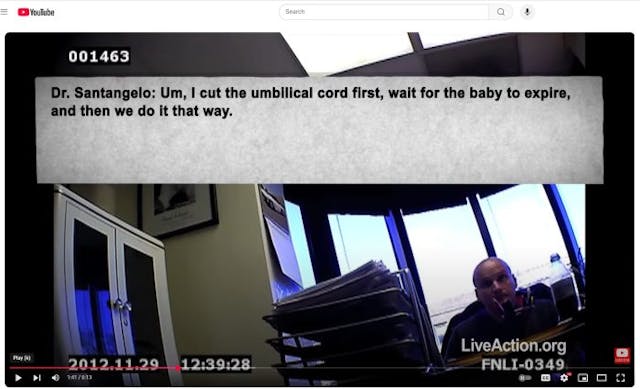
NICU babies are adorable in their 'ugly Christmas sweaters'
Nancy Flanders
·
Pro-life group hopes to show insurer that late-term abortionist’s business is ‘a liability’
Pro-life activists claim the insurance company of late-term abortionist Cesare Santangelo may soon be put ‘on notice’ that he is potentially violating District of Columbia requirements that a doctor be competent to perform surgeries.
The recent appearance of late-term abortionist Cesare Santangelo at his facility has led some to speculate that he may be unfit to commit abortions.
Pro-life activists are seeking to put his insurer ‘on notice’ as to the potential dangers patients may face due to Santangelo’s physical limitations.
Santangelo has been suspected of using a risky procedure known as umbilical cord transection to kill preborn babies before completing abortions; experts say this puts women at significant, unnecessary risk.
Santangelo is not alone. Many late-term abortionists commit risky procedures outside hospital settings, which goes against the ‘standard of care.’
Santangelo was recently spotted entering his late-term abortion facility, the Washington Surgi-Clinic, in D.C. He had a cast on his right arm and appeared unable to walk without assistance.
Local activists have claimed on video that they have filed Freedom of Information Act (FOIA) requests to discover what malpractice insurance is held by the facility, to put the insurer ‘on notice’ of possible dangers due to the abortionist’s physical limitations.
“We need to know how Santangelo could possibly be doing abortions with his arm in a cast, with neuropathy, being a fall risk, not even being able to drive himself — yet he’s claiming to do these abortion procedures which are physically difficult to do,” pro-life activist Kristin Turner says in the video below. “One of the other points… is to figure out who the Surgi-Center’s malpractice insurance is and then contact… to convince them that the facility’s a liability.”

Medical malpractice attorney Mike Seibel told Live Action News, “Umbilical cord transection often requires a doctor to reach far into the uterus in an attempt to locate the umbilical cord. A doctor without full use of both arms possibly puts the patient at risk for complications and might also violate 3-1205.14(5) of the District of Columbia code.” He added that “Authorities should immediately investigate whether he is physically competent to perform this type of procedure without endangering the patient.”
That code suggests that the revocation of a license could be imposed when the licensee “is professionally or mentally incompetent or physically incapable.”
During Live Action’s Inhuman investigation, an undercover investigator visited the Washington Surgi-Center owned by Santangelo. Santangelo appeared to describe in that undercover video a dangerous procedure known as an umbilical cord transection (UCT), and expressed willingness to let babies born alive during abortions “expire” without medical assistance.
During Live Action’s investigation, Santangelo told the 25-weeks-pregnant undercover investigator, “I cut the umbilical cord first, wait for the baby to expire, and then we do it that way. So hopefully the fetus will expire first….”

Asked by the investigator if he removes the baby “intact,” Santangelo responded, “We try. Yeah that’s the whole reason why we do the dilation today and tomorrow.”
Asked if the baby ever moves when it comes out, Santangelo responded, “That’s why I try and sever the umbilical cord first, and we wait for that to stop pulsing, and this way the fetus is expired first, so it doesn’t” (emphasis added).

It is unclear whether Santangelo still commits UCTs, as his website currently only describes D&E (dismemberment) abortions. However, the undercover video implies that he previously committed induction abortions, which fall below the ‘standard of care’ when committed outside a hospital or hospital-like setting. They also suggest that Santangelo may be utilizing UCT for fetal demise.

A UCT describes a procedure in which an abortionist severs the preborn child’s umbilical cord while he or she is still in the womb in order to “induce fetal demise.” According to a 2013 study on this abortion method, this sends the preborn baby into cardiac arrest.
In Planned Parenthood v. Yost, late-term abortionist Lisa Keder, then-Professor and Vice Chair of the Ohio State University Wexner Medical Center’s Department of Obstetrics and Gynecology and Division Director for General OB/GYN, described a UCT in her testimony:
So umbilical cord transection is a description of grasping the umbilical cord and interrupting the blood flow… from the placenta to the fetus in the course of doing the procedure prior to any other extraction of fetal tissue from the uterus.
Keder said this could take as long as 11 minutes to complete. She continued:
Article continues below
Dear Reader,
In 2026, Live Action is heading straight where the battle is fiercest: college campuses.
We have a bold initiative to establish 100 Live Action campus chapters within the next year, and your partnership will make it a success!
Your support today will help train and equip young leaders, bring Live Action’s educational content into academic environments, host on-campus events and debates, and empower students to challenge the pro-abortion status quo with truth and compassion.
Invest in pro-life grassroots outreach and cultural formation with your DOUBLED year-end gift!
So a typical abortion procedure… takes about 10 to 15 minutes to perform in the second trimester, so this could potentially double the amount of time that’s required to complete the surgery. The longer a patient is under anesthesia, the more risk there is. The longer it takes for us to complete a procedure, the greater the risk of infection potentially is.
It also requires reaching into the uterine cavity to find an umbilical cord which might require that we reach multiple times into the uterine cavity or more times into the uterine cavity than we typically would which might increase the risk of injury to the cervix or the uterus.
And there’s the potential if the patient starts bleeding while we’re waiting for fetal demise to occur, that she could have an increased blood loss associated with the procedure.
Keder acknowledged that there were no medical benefits to the abortion patient from a UCT procedure. Asked what the abortionist would be doing during a transection, Keder responded:
I would imagine that the doctor would have an assistant who would be using an ultrasound to try to identify structures within the uterus and the doctor would have an instrument inside the uterus attempting to see if they could locate the cord by trying to grasp it or using a suction device to try to pull the umbilical cord through the cervix so it could be visually identified.
It is unclear how many outpatient abortion facilities use UCT, but what is clear is that the method is “unpredictable” with “inherent risks,” according to an American College of Obstetricians and Gynecologists (ACOG) brief in Frederick W. Hopkins v. Larry Jegley:
Attempting fetal demise by transecting the umbilical cord requires a physician to rupture the amniotic membrane by inserting a suction tube or other instrument, such as forceps, into the uterus to grasp the umbilical cord, if possible, and sever it. Cord transection is a technically challenging, rarely used, unpredictable procedure.
First, rupturing the amniotic membrane causes amniotic fluid to drain. This immediately causes the uterus to compress, making it difficult to identify the cord and increasing the likelihood that the physician’s instruments may injure the woman. Second, the procedure’s success depends in large part on the placement of the umbilical cord. If the umbilical cord is blocked by the fetus, it may be difficult and risky for a physician to attempt to reach it.
Attempting to transect the umbilical cord involves inherent risks. If a physician begins the procedure but ultimately determines that transection is not possible, the patient is left with a ruptured amniotic membrane, creating a high risk of infection.
The procedure can also create blood loss, placental separation, contractions, infection, and even uterine perforation.
Keder testified in Yost:
No evidence currently supports the use of induced fetal demise to increase the safety of second-trimester medical or surgical abortion. Techniques used to cause fetal demise include division of the umbilical cord, intra-amniotic or intra fetal digoxin injection, or fetal intracardiac potassium chloride injection.
In other words, killing the preborn child first isn’t a matter of safety for the woman; it’s a matter of preventing the “dreaded complication” of an abortion survivor — whom Santangelo stated in Live Action’s undercover video that he “would not help.”
Keder added, “[E]very time we introduce an instrument into the uterine cavity, we’re placing it through the vagina which is not a sterile environment, so there’s increased risk of introducing infection. We’re placing instruments through the… cervix which can traumatize the cervix, and the potential also for uterine perforation exists as well….”
She claimed that the risks of using UCT “include the risk of prolonging the procedure, which would potentially increase the risk of infection and hemorrhage associated with the surgery,” and if it failed to kill the baby, “there would be substantial risk of complication associated with an incomplete abortion.”
Though Santangelo advertises second-trimester D&E dismemberment abortion procedures on his website, five late term aborted babies obtained by pro-life activists from Santangelo’s abortion facility were discovered to be largely intact, leading some to speculate that Santangelo may be committing federally illegal partial-birth (D&X) abortions in addition to UCT to kill preborn babies. Google reviews for the facility indicate late-term abortions are happening there.
Live Action News’ series on late-term abortion has shown the industry’s willingness to put women at risk in order to kill their preborn children later in pregnancy, even up to birth. The industry is operating outside the ‘standard of care’ by committing risky and dangerous procedures in outpatient facilities. As such, the industry should be put ‘on notice’ and government agencies and corporations which fund or insure these later abortions should also be notified of the unreasonably dangerous conditions to which women are subjected inside abortion facilities.
Follow Live Action News on Facebook and Instagram for more pro-life news.
Live Action News is pro-life news and commentary from a pro-life perspective.
Contact editor@liveaction.org for questions, corrections, or if you are seeking permission to reprint any Live Action News content.
Guest Articles: To submit a guest article to Live Action News, email editor@liveaction.org with an attached Word document of 800-1000 words. Please also attach any photos relevant to your submission if applicable. If your submission is accepted for publication, you will be notified within three weeks. Guest articles are not compensated (see our Open License Agreement). Thank you for your interest in Live Action News!

Nancy Flanders
·
Analysis
Cassy Cooke
·
Analysis
Cassy Cooke
·
Analysis
Cassy Cooke
·
Analysis
Cassy Cooke
·
Analysis
Nancy Flanders
·
Abortion Pill
Carole Novielli
·
Abortion Pill
Carole Novielli
·
Investigative
Carole Novielli
·
Abortion Pill
Carole Novielli
·
Investigative
Carole Novielli
·